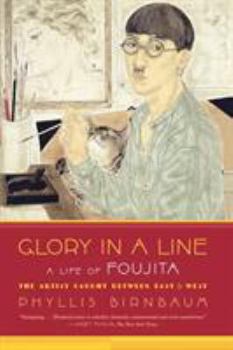Glory in a Line
Select Format
Select Condition 
Book Overview
The first biography in English of the Japanese artist who was a central figure in the dazzling artistic milieu of 1920s Paris
When we think of expatriates in Paris during the early decades of the twentieth century, certain names come to mind: Hemingway, Picasso, Modigliani--and Foujita, the Japanese artist whose distinctive works, bringing elements of Japanese art to Western oil painting, made him a major cultural figure in 1920s Montparnasse. Foujita was the only Japanese artist to be considered part of the "School of Paris," which also counted among its members such prominent artists as Picasso and Modigliani. Noteworthy, too, was Foujita's personal style, flamboyant even for those flamboyant times. He was best known for his drawings of female nudes and cats, and for his special white color upon which he could draw a masterful line--one that seemed to outline a woman's whole body in a single unbroken stroke. With the advent of the Second World War, Foujita returned to Japan, where he allied himself with the ruling Japanese mili-tarists and painted canvases in support of the war effort. After Japan's defeat, he was scorned for his devotion to the military cause and returned to France, where he remained until his death in 1968. Acclaimed writer and translator Phyllis Birnbaum not only explores Foujita's fascinating, tumultuous life but also assesses the appeal of his paintings, which, in their mixture of Eastern and Western traditions, are memorable for their vibrancy of form and purity of line.Format:Paperback
Language:English
ISBN:0865479755
ISBN13:9780865479753
Release Date:November 2007
Publisher:Farrar, Strauss & Giroux-3pl
Length:352 Pages
Weight:1.10 lbs.
Dimensions:1.0" x 5.6" x 8.6"
Customer Reviews
3 ratings
A wonderful read!
Published by Thriftbooks.com User , 17 years ago
I've always wondered about the single Japanese artist I've seen represented in European museum collections of early 20th century art. Who was this Foujita, what brought him to Europe, and what made him famous? Birnbaum's book tells all! The reader gets a sense of the splendid figure Foujita cut in Paris with his wild clothing and antics, but also the tight-rope he walked--trying to be Japanese enough to appeal to French buyers who loved Japonisme but also trying to find room for his original style. Birnbaum gives the sense of what her journey was like, taking the reader to Tokyo and Paris to talk with those who knew Foujita. A thoroughly enjoyable read!
Foujita Re-discovered
Published by Thriftbooks.com User , 18 years ago
As I read Phyllis Birnbaum's GLORY IN A LINE, I fought a sense of disbelief. How was it during my 1960s training in art and art history I had never heard or read this artist's name? In fact, if it had not been for Birnbaum's book or my perusal of Christie's or Sotheby's auction catalogs of only recent years, I might not have heard the name Foujita, still. But then, there is a fairy-tale sense of fantasy to this artist's life that may account for my incredulity. Birnbaum reveals in a humorous, sometimes deadpan, gathering-of-facts style, the artist's amazing and vivid life. Leaving it to the reader to configure, Birnbaum reports that Foujita constructed a fabulously successful social life, rather like, this reader supposes, an early modernist Andy Warhol. Despite being newly arrived in Paris, and knowing little French, the Japanese Foujita took to the Bohemian life-style like a duck to water. He displayed far more joie de vivre than any Left Bank artist (among his friends were Modigliani, Soutine and others). Then, after years of celebrity in Paris and more years traveling, the mercurial Foujita returned to Japan and virtually led the Japanese propagandist art program for World War II. Birnbaum has a knack for seting up scenes with great economy: meeting a Frenchman from his former deveil-may-care life in Paris, Foujita entered the room in full military garb,and greeted the visitor with a smile-less, stiff, formal bow,instead of shaking hands. Foujita, the perfect super-chameleon, or better yet--Zelig. Then, this reader thought perhaps it was because of his Japanese war art that Foujita was omitted from earlier art history texts, to be discussed only now. Indeed as of this writing, an American war movie about Iwo Jima told from the Japanese point of view is of recent release. With this in mind Birnbaum's book seems prescient. Read her book as an illuminating and entertaining biograpy of an incredible life, not as a moralizing document or an analysis of Foujita's work in the context of 20th Century art history.
glory in a line: a life of foujita
Published by Thriftbooks.com User , 18 years ago
I FIRST BECAME AWARE OF FOUJITA IN 'KI KI'S PARIS'. I LOVE THE BOHEMIAN PARIS OF THE 1920'S WITH ALL THOSE ARTISTS AND WRITERS CREATING AND PARTYING , THRIVING AND STARVING AND BASKING IN THE GLORY THAT WAS PARIS. PHYLLIS BIRNBAUM'S BOOK IS QUITE GOOD, BUT I WOULD LIKE TO HAVE DISCOVERED MORE ABOUT THE 'CREATIVE' MAN, THE GENIUS WITHIN. AND I WISH THERE HAD BEEN MORE PHOTOS OF HIS MANY ART WORKS. HE WAS QUITE A COMPLEX MAN AND THE BIO, WHILE INFORMATIVE, DOESN'T CAPTURE HIS CREATIVE PROCESS ENOUGH FOR ME. I DO RECOMMEND THE BOOK. I HOPE SOMEONE WILL WRITE ANOTHER BOOK OF JUST HIS PARIS YEARS.






